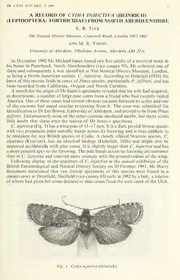
A record of Cydia injectiva (Heinrich) (Lepidoptera: Tortricidae) from North Aberdeenshire PDF
Preview A record of Cydia injectiva (Heinrich) (Lepidoptera: Tortricidae) from North Aberdeenshire
BR. J. ENT. NAT. HIST., 7: 1993 1 A RECORD OF CYDIA INJECT/VA (HEINRICH) (LEPIDOPTERA: TORTRICIDAE) FROM NORTH ABERDEENSHIRE K. R. Tuck The NaturalHistory Museum, Cromwell Road, London SW75BD AND M. R. Young University ofAberdeen, Tillydrone Avenue, Aberdeen AB9 2TN. In December 1992 Mr Michael Innes found two live adults ofa tortricid moth in his home in Peterhead, North Aberdeenshire (vice-county 93). He collected one of these and subsequently it was identified at The Natural History Museum, London, as being a North American species, C. injectiva. According to Heinrich (1926) the larva ofthis species feeds in cones ofPinusspecies, particularlyP.jeffreyi, and has been recorded from California, Oregon and North Carolina. A search fortheoriginofMr Innes'sspecimensrevealedthat hiswifehadacquired, as decorations, a number oflarge pinecones from a friend who had recentlyvisited America. Oneoftheseconeshad severalobviouscocoonsbetween its scalesandone of the cocoons had pupal exuviae projecting from it. The cone was submitted for identificationto DrIan Brown, UniversityofAberdeen, andprovedtobefromPinus jeffreyi. Unfortunately none ofthe othercocoons produced moths, but there seems little doubt that these were the source of Mr Innes's specimens. C injectiva(Fig. 1)hasawingspanof 15-17mm. It isadarkgreyishbrownspecies with two prominent paler metallic bands across its forewing and is thus unlikely to be mistaken for any British species of Cydia. A closely related Nearctic species, C piperana (Kearfott), has an identical biology (Heinrich, 1926) and might also be imported accidentally with pine cones. It is slightly larger than C. injectivaand has amorepointed apextotheforewing. Thepalebandsacrossits forewingarenarrower than in C. injectivaand contrast more strongly with the ground-colour ofthe wing. Following display ofthe specimen of C. injectiva at the annual exhibition of the British Entomological and Natural History Society on 30 October 1993, Mr Harry Beaumont mentioned that two female specimens of this species were found in a conservatoryat Dronfield, Sheffield(vice-county63)earlyin 1982byalady, arelative ofwhom had given her somedecorativepinecones from thewest coast ofthe USA. Fig. 1. Cydia injectiva (Heinrich). 2 BR. J. HNT. NAT. HIST.,7: 1994 Oneofthesespecimensisnow in Mr Beaumont'scollection; the locationoftheother is uncertain. Mr Innes has kindly donated his specimen ofC. injectiva to the collection ofThe Natural History Museum, London. Reference Heinrich, C. 1926. Revision ofthe North American moths ofthe subfamilies Laspeyresiinae and Olethreutinae. Bull. U.S. Natn. Mus. 132: 1-216. BOOK REVIEW Dorset hoverflies by D. A. Levy, E. T. Levy and W. F. Dean, with illustrations byM. J. Levy, published bytheauthors in associatio—n with the Dorset Environmental Records Centre, 1992, 73 pages, paperback, £3.95. This is the latest county atlas forhoverflies, followingon from previous publications forEssex, Staffordshireand Warwickshire. All such atlases are labours oflove, though none convey the passion thatcanbederived fromhoverflyrecordingas much asthisone. Thebookletprovides a brief introduction to hoverflies written for the layman, a section on the history ofhoverfly recording in Dorset (with special reference to J. C. Dale, F. H. Haines, C. D. Day, Capt. C. Diver and the Harwoods) and briefaccounts ofa locality and species of special interest. The remainder of the booklet consists of approximately 200species mapsandspeciesaccountsarranged fourperpage. Themaps usea 10-km squaregrid, thoughwith fourdots persquare(i.e. 5-km squareunits). Thisprovides a far better indication of frequency at a county level than 10-km square units. Unfortunatelythe maps fail to make adistinction between modern and old records, using solid black circles throughout. The species accounts are short but informative, providing information on Dorset status and habitat preferences, Dorset flight periods, and an indication ofwhen the species was first recorded in the county. Unfortunately the text is slightly marred by a small number ofspelling mistakes, inconsistencies, questionable interpretations of data and minor inaccuracies. Does theexpression "common in manyvaried habitats" actually mean 'common, utilizing awidevarietyofhabitats'? It seems strangethatXylotinanemorum and Sericomyia lapponaaretermed 'locallycommon' whenotherspecieswith asimilarspreadacross the county and similar number of new and old localities, such as Brachypalpoides lenta and Volucella inflata, are termed 'scarce', 'local and thinly spread' etc. Does Anasimyialineata, whichhassemi-aquaticlarvaeandastrongassociationwithmarshes andwatermarginselsewhereinBritain, really favour'heathsandgrassland' in Dorset, or is this just clumsy interpretation? Theauthorsarenotshyofchallengingacceptedthinkingandexpressingtheirown opinions, which is a healthy state of affairs in British dipterology. The most controversial statement concerns the attempted sinking of Cheilosiagriseiventris as a subspecies of C. intonsa. This will be widely rejected by dipterists familiar with both species, even if females are particularly troublesome to separate. The use of the subspecies category is itselfa contentious matter in such circumstances, and one hastoquestionwhetherit iswithin therealmsofanon-refereedpublicationtoattempt nomenclatural revision. Aside from these criticisms, this is a very welcome publication with much new information. Steven J. Falk
